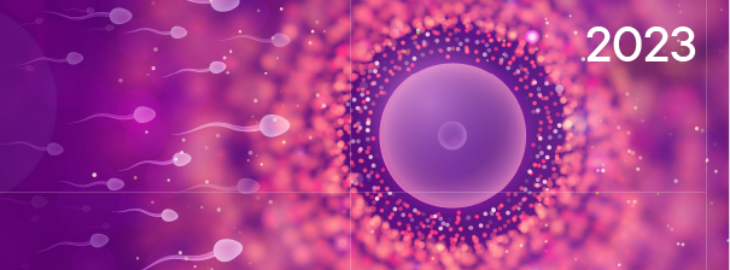Presenting the research to the 39th annual meeting of the European Society of Human Reproduction and Embryology (ESHRE) [1], Dr Nada Kubikova from the University of Oxford (UK), said: “Gene editing has the potential to correct defective genes, a process that usually involves first breaking and then repairing the DNA strand. Our new findings provide a warning that commonly-used gene editing technologies may have unwanted and potentially dangerous consequences if they are applied to human embryos.”
She described how she evaluated the gene editing tool, CRISPR-Cas9, to cut out and replace sections of DNA in early embryo cells.
“Our results show that the use of CRISPR-Cas9 in early human embryos carries significant risks,” she said. “We have found that the DNA of embryo cells can be targeted with high efficiency, but unfortunately this rarely leads to the sort of changes needed to correct a defective gene. More often, the strand of DNA is permanently broken, which could potentially lead to additional genetic abnormalities in the embryo.”
Gene editing has begun to be used in children and adults with diseases caused by gene mutations such as cystic fibrosis, cancer and sickle cell disease. Many more inherited disorders could be avoided if gene editing could be carried out on embryos before they implant in the womb, since this is the only stage of development when CRISPR-Cas9 technology can be guaranteed to reach every cell of the embryo. However, because it has the potential to create changes in the human genome that would be passed down the generations, and because of uncertainty about its safety, its use in embryos is currently banned in most countries worldwide [2].
“Significant gaps in our knowledge still remain,” said Dr Kubikova. “We wanted to evaluate whether CRISPR-Cas9 could be an effective method for correcting genetic mistakes in human embryos and to shed light on whether such methods would be safe to use.”
In an ethically approved study, Dr Kubikova and her colleagues fertilised donated eggs with donated sperm using intracytoplasmic sperm injection (ICSI) to create 84 embryos. In 33 of the embryos, they used CRISPR-Cas9 to create breaks in the two strands that make up the DNA molecule – known as DNA double-strand breaks.
“We used CRISPR to target areas of the DNA that don’t contain any genes,” said Dr Kubikova. “This is because we wanted to learn what is always true about how CRISPR affects embryo cells and their DNA, and not be distracted by changes caused by disrupting a particular gene.”
The remaining 51 embryos were kept as controls.
“All the cells of the body have highly efficient mechanisms for repairing damage affecting their DNA. In most cases, the ends of broken DNA strands are quickly reconnected. This is very important, as the persistence of unrepaired DNA damage stops cells working properly and can be lethal. The most common way that cells repair DNA is by reconnecting the two ends of the DNA strand, although when this happens it is common for a few letters of genetic code to be deleted or duplicated at the site where the strands are reattached. This can disrupt genes and does not allow mutations to be corrected. This is known as non-homologous end joining,” said Dr Kubikova.
“Another way cells can repair a break in the DNA is by using an intact copy of the affected area as a template, copying it and replacing the damaged area as it does so. It is possible to supply the cells with pieces of DNA containing slightly altered DNA sequences, such as having a normal sequence rather than a mutation. The cell may then use these templates when it repairs the break produced by CRISPR, removing the broken piece of DNA and copying the rest of the supplied sequence at the same time. This is known as homology directed repair and is the process required for correcting a mutation.”
The researchers detected alterations at the targeted DNA sites in 24 out of 25 embryos, indicating that CRISPR is highly efficient in the cells of human embryos. However, only nine percent of targeted sites were repaired using the clinically useful process of homology directed repair. Fifty-one percent of broken DNA strands underwent non-homologous end joining, producing mutations where the strands were reconnected. The remaining 40% of broken DNA strands failed to be repaired. The unrepaired breaks in the DNA strands eventually led to large pieces of chromosome, which extend from the site of the break to the end of the chromosome, being lost or duplicated. Abnormalities of this type affect the viability of embryos and if affected embryos were transferred to the uterus and produced a baby, they would carry a risk of serious congenital abnormalities.
“Our study shows that homology directed repair is infrequent in early human embryos and that, in the first few days of life, the cells of human embryos struggle to repair broken DNA strands. CRISPR-Cas9 was remarkably efficient in targeting the DNA site. However, the majority of cells repaired the DNA break induced by CRISPR using non-homologous end joining, a process that introduces additional mutations rather than correcting existing ones. This would be a challenge if there were attempts to use CRISPR-Cas9 to correct inherited disorders in human embryos, as it suggests that most times when it is attempted, it will not be successful,” said Dr Kubikova.
“While the results caution against the use of genome editing in human embryos, there were some positive findings, suggesting that risks can be lowered and the ability to successfully remove mutations can be increased by modifying the way in which genome editing is undertaken. This offers hope for future improvements to the technology.
“On average, only about a quarter of the embryos created using IVF succeed in producing a baby. Half of them stop developing in the laboratory before they can be transferred to the womb. The inability of embryos to efficiently repair DNA damage, revealed by this study, may explain why some IVF embryos fail to develop. This understanding may lead to improved IVF treatments,” she said.
Now, the researchers will look for new ways to protect early embryos from DNA damage, which could lead to potential improvements in fertility treatments. They also plan to explore more gentle methods of gene editing that avoid breakage of the DNA strands, which embryos might find easier to cope with.
“In the future, such methods may offer the possibility of reversing mutations that have blighted families for generations, preventing the inheritance of catastrophic disorders,” concluded Dr Kubikova.
The chair-elect of ESHRE, Professor Karen Sermon, Head of the Reproduction and Genetics Research Group, Vrije Universiteit Brussel, Brussels (Belgium), was not involved with the research. She commented: “This is an excellent study by Dr Kubikova and her colleagues. It underlines the importance of why gene editing needs to be thoroughly researched and understood before any attempt is made to gene edit human embryos.
“I think it’s likely that gene editing will become a useful tool at some point in the future for preventing babies from being born with serious genetic diseases in a restricted number of cases where preimplantation genetic testing would not apply. However, this research shows one of the ways that it can go wrong. It will be some time before we can be confident that we really understand how to use it successfully without any unwanted and unexpected surprises. It will require stringent regulation. In the meantime, careful research such as this brings us one step closer, and may also help with understanding how to improve fertility treatments.”
[ENDS]
[1] Presentation no: O-075, “Deficiency of DNA double-strand break repair in human preimplantation embryos revealed by CRISPR-Cas9”, presented by Dr Nada Kubikova et al, Session 24: The genetic content of preimplantation embryo: prediction, detection and repair, Hall D4, 15.15 hrs CEST, Monday 26 June 2023.
[2] In 2018, Chinese scientist, He Jiankui, announced he had created the world’s first gene-edited babies to try to protect them from HIV. The scientific community condemned the work because of safety concerns and Jiankui was jailed for three years in December 2019 for violating a Chinese ban on gene editing human embryos.
Notes for editors
According to the UK Academy of Medical Science’s press release labelling system, this is a non-peer reviewed, experimental study in human embryos
Funding: The principal scientist, Dr Kubikova, was funded by Jesus College, Oxford, while all other study costs were provided by Juno Genetics, a company that seeks to understand serious genetic conditions in IVF embryos and during pregnancy and develop new tests for their diagnosis.

